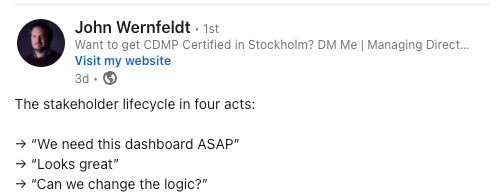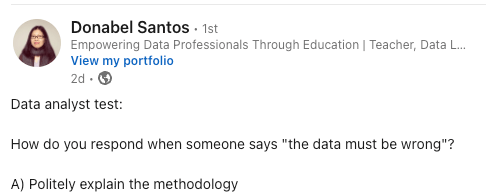
READ TIME: 6 MINUTES
Not All AI Notetakers Are Secure. Here’s the Checklist to Prove It.
You wouldn’t let an unknown vendor record your executive meetings, so why trust just any AI?
Most AI notetakers offer convenience. Very few offer true security.
This free checklist from Fellow breaks down the key criteria CEOs, IT teams, and privacy-conscious leaders should consider before rolling out AI meeting tools across their org.
👂🏼 Most people have heard of OKRs…
But a good chuck of them have no idea what they are - or why they exist.
If that’s you, don’t sweat. Today we’re going to dive into OKRs, figure out what the hell they are, how to use them, and why they are so valuable in aligning data team efforts with overall business goals!

These guys smash their OKRs
But before all of that, a little poll for you
💡 How well are OKRs actually used in your company or role?
(check out last week’s poll results down below)
😖 Why data leaders struggle with OKRs
If you’re a data leader, you’ve likely been told:
“Align your OKRs with the business strategy.”
And you’re like, “what hell does that mean?”
When you sit down to actually write them, it can feel incredibly vague:
What actually goes into a data team OKR?
How do they align with the company’s goals?
How do you evaluate progress meaningfully?
These are common questions people tasked with writing OKRs find themselves asking.
Most data leaders I work with either:
Ignore OKRs altogether because they seem disconnected from daily work, or
Treat them as a to-do list rather than a system to drive impact.
So, here’s how to approach OKRs so your data team becomes a strategic asset, not a reporting factory.
🚫 I scroll Data LinkedIn so you don’t have to!
Here are my top 3 data posts from the last week:
John Wernfeldt - The Dashboard Life Cycle
John Cook - More Non-Data Data Leaders, Please
Donabel Santos - What To Say When Told “The Data Must Be Wrong”
🤷 So what actually are OKRs?
OKRs have 2 parts: the Objective, and the Key Results. Here’s how that is broken down:
🥅 Objective: What you want to achieve.
Ambitious, inspiring, direction-setting.
📈 Key Results: How you’ll measure progress toward that objective.
Specific, measurable, outcome-based.
The objective is designed to get everyone excited behind a goal. It should be clear, memorable and exciting. It’s the part that everyone should be able to rattle off by heart.
Key results are the the way we quantify our progress towards the objective.
For that reason they must be tangible and reportable. They can be binary - as in, “yes we accomplished it” or, “no we didn’t get it done”, or they can be tracking - we are 90% of the way towards accomplishing this objective.
🎯 Let’s look at an example
The below OKR is an example for an individual data team member. OKRs do not exist in isolation and for them to be effective they need to ladder up to team and company goals to ensure everyone’s effort is aligned towards the correct things.
In the next section we’ll take a look at how that alignment works, but for now, let’s just focus on one person’s OKRs - that of a Data Analyst:
Objective (thing we want to achieve):
Drive customer retention by delivering clear churn insights to Customer Success.
Key Results (How we measure progress toward objective):
Complete analysis to identify the top 5 drivers of customer churn within 4 weeks.
Collaborate with data science to create model features improving predictive power by 10%.
Build a clear, user-friendly churn insights dashboard for Customer Success with weekly updates.
Collect feedback from 5 Customer Success users and iterate the dashboard based on their needs.
You’ll notice that the objective is simple yet lofty, but in itself, not entirely quantifiable. That’s where the key results come in. These are the activities that we need to undertake to ensure that the objective is met.
As you’ll see each of these is quantifiable and measurable. Most of them contain numbers and/or time constraints while the 3rd one is essentially binary - i.e. is it done or not?
Now we’re going to take a look at how this individual’s OKRs ladder up to team and company OKRs and how those align to organisational strategic pillars.
The Bad Ass Bookshelf is an online bookclub for leaders and aspiring leaders ready to learn, share, and level up with the best books on business, management, productivity, and personal development.
During the month of July, our members voted to read Slow Productivity by Cal Newport!
If you’re keen on personal and professional development and want to be a part of vibrant and growing community of book lovers then come join us at The Bad Ass Bookshelf!
🪜 How OKRs ladder up
Take a look at the image below to see an example of how ORKs cascade down throughout the business.
All the way from the organisational strategic pillar at the very top, down through company wide ORKs that will be owned by various executives, on to data team OKRs that will be owned by the data team leader, and through to the individual data team member’s own set of OKRs.

When correctly applied, the individual contributor at the bottom of the image can clearly see how their daily efforts contribute to the broader organisational strategy.
Each of us through out the organisation can understand and clearly see why a particular activity is so crucial, and allow them to prioritise their own workload to ensure that they too are a rowing in the same direction as all of their colleagues 🚣
💡 Why this works
✅ Direct line of sight from strategy → company → data team → individual.
✅ Everyone knows why their work matters.
✅ Measurement focuses on impact, not tasks (no “attend 10 meetings” as a KR).
✅ Regular check-ins help prioritise and adjust as needs evolve.
✍🏻 How to write better OKRs
1️⃣ Start with the business strategy. What is the company trying to achieve? Retention, expansion, efficiency, profitability?
2️⃣ Ask: “How can data enable this?” Avoid jumping straight to tasks/tools.
3️⃣ Frames your objectives as an outcome. E.g., “Enable churn reduction,” not “Build churn model.”
4️⃣ Define key results as measurable outcomes, not activities. “improve predictive power by 10%” is a KR. “Build model” is not.
5️⃣ Check for alignment. Can you draw a line from your KR to the company’s goals?
6️⃣ Keep it tight. 1–3 OKRs per team/individual per quarter. Focus beats volume every time.
📋 Evaluating OKRs
At the end of the cycles (quarter, EoY etc.) ask yourself and your team the following question in relation to their OKRs:
✅ Did you hit your key results? By how much?
✅ Did achieving them move the business closer to its objective?
✅ What did you learn about prioritisation and blockers?
✅ What will you adjust next cycle?
While OKRs can be used in evaluating an individual’s performance, they are much more powerful in determining the cohesiveness of the overall business. They are very useful at helping you identify blockers and contingencies on other teams or individuals that might be slowing things down.
ORKs are not a box ticking activity. They are a strategic activity and work best when they are thoughtfully written, frequently monitored, transparently reported and reflectively evaluated.
💭 Final thought on OKRs…
Most data leaders overcomplicate OKRs or dismiss them as “BS management theatre.”
But when used well, OKRs are a practical leadership tool to:
Prioritise work that matters.
Align your team to strategy.
Track progress meaningfully.
Make your data team a strategic asset, not a service desk.
And unlike a lot of the work we do in data, ORKs are tangible and measurable.
Give them a go - done well, they can have tremendous impact on your data leadership outcomes.
✨ Affordable self-paced coaching products
For anyone interested in data leadership coaching, but concerned about the cost, I’ve got something great for you.
I’ve put together 2 self paced coaching products I know you’re going to love.
DIY Coaching - This self-paced email series and accompanying exercises provides actionable tools to help data professionals navigate career transitions, set goals, and achieve success.
Data Leadership Frameworks - This self paced email series contains 10 value-packed frameworks, each tackling and tearing down major data leadership challenges.
Check the links above to learn more!!

Tristan Burns
💡 Helpful resources for data professionals:
The Data Leadership Frameworks: This email series containing 10 data leadership frameworks, will equip you with the necessary skills and knowledge to maximise your effectiveness and become the influential and powerful data leader you know you can be.
DIY Coaching Program: Through a series of 9 self-guided exercises, you’ll clarify your goals, overcome obstacles, and create a plan for your next career move - all at your own pace.
⚡️Three more ways I can help you:
Private Coaching for Data Leaders: I work with data professionals looking to grow into influential and unstoppable data leaders to help them navigate and overcome the challenges of being a data leader.
Group coaching for Data Teams: Great data teams can make or break businesses. Through my facilitated 6-week group coaching program, together we get to the heart of what is holding teams back and set a course for data-driven success.
Google Analytics, Tagging and Looker Support: Helping teams to set up or optimising their data eco system, generate actionable insights and gain more in-depth knowledge through training.
⚡️ Previous poll results
Last week I asked you: What’s the hardest part about simplifying your message for stakeholders?
Here’s how you responded:

What did you think of this email?
If you enjoyed this newsletter, why not forward it to a friend.
Did someone forward you this email? You can subscribe to Strategies for Effective Data Leaders here!







